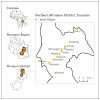Process Evaluation of a Community-Based Microbial Larviciding Intervention for Malaria Control in Rural Tanzania
- PMID: 33036350
- PMCID: PMC7579308
- DOI: 10.3390/ijerph17197309
Process Evaluation of a Community-Based Microbial Larviciding Intervention for Malaria Control in Rural Tanzania
Abstract
Microbial larviciding can be an effective component of integrated vector management malaria control schemes, although it is not commonly implemented. Moreover, quality control and evaluation of intervention activities are essential to evaluate the potential of community-based larviciding interventions. We conducted a process evaluation of a larval source management intervention in rural Tanzania where local staff were employed to apply microbial larvicide to mosquito breeding habitats with the aim of long-term reductions in malaria transmission. We developed a logic model to guide the process evaluation and then established quantitative indicators to measure intervention success. Quantitative analysis of intervention reach, exposure, and fidelity was performed to assess larvicide application, and interviews with larviciding staff were reviewed to provide context to quantitative results. Results indicate that the intervention was successful in terms of reach, as staff applied microbial larvicide at 80% of identified mosquito breeding habitats. However, the dosage of larvicide applied was sufficient to ensure larval elimination at only 26% of sites, which does not meet the standard set for intervention fidelity. We propose that insufficient training and protocol adaptation, environment and resource issues, and human error contributed to low larvicide application rates. This demonstrates how several small, context-specific details in sum can result in meaningful differences between intervention blueprint and execution. These findings may serve the design of other larval source management interventions by demonstrating the value of additional training, supervision, and measurement and evaluation of protocol adherence.
Keywords: Tanzania; implementation assessment; larval source management; malaria; microbial larvicide; process evaluation; vector control.
Conflict of interest statement
The authors declare no conflict of interest.
Figures






References
-
- World Malaria Report 2019. World Health Organization; Geneva, Switzerland: 2019.
-
- Kramer R.A., Mboera L.E.G., Senkoro K., Lesser A., Shayo E.H., Paul C.J., Miranda M.L. A randomized longitudinal factorial design to assess malaria vector control and disease management interventions in rural Tanzania. Int. J. Environ. Res. Public Health. 2014;11:5317–5332. doi: 10.3390/ijerph110505317. - DOI - PMC - PubMed
-
- Fillinger U., Kannady K., William G., Vanek M.J., Dongus S., Nyika D., Geissbühler Y., Chaki P.P., Govella N.J., Mathenge E.M., et al. A tool box for operational mosquito larval control: Preliminary results and early lessons from the Urban Malaria Control Programme in Dar es Salaam, Tanzania. Malar. J. 2008;7:20. doi: 10.1186/1475-2875-7-20. - DOI - PMC - PubMed
Publication types
MeSH terms
LinkOut - more resources
Full Text Sources
Medical

